Every high altitude baker needs a reliable high altitude chocolate cake recipe. This easy recipe makes a moist and fluffy chocolate cake that’s perfected for mountain bakers, so you get perfect, delicious results every time. Frosted with fluffy chocolate buttercream, this is a classic cake for chocolate lovers.
I bake and test all of my recipes at Denver’s altitude of 5,280 feet, so if you live at a higher or lower elevation, you may need to make a few minor adjustments, but don’t worry! It’s easy to adjust a recipe for perfect results at any altitude. This chocolate sour cream cake is so easy to make, and the batter comes together quickly with just a bowl and whisk! And if the price of eggs lately has you baking less, I even have an eggless chocolate cake variation (noted in the FAQs above the recipe card) for today’s recipe.
Looking for more classic high altitude cake recipes? Don’t miss this almond poppy seed cake, vanilla cake, coconut cake, and white velvet cake.
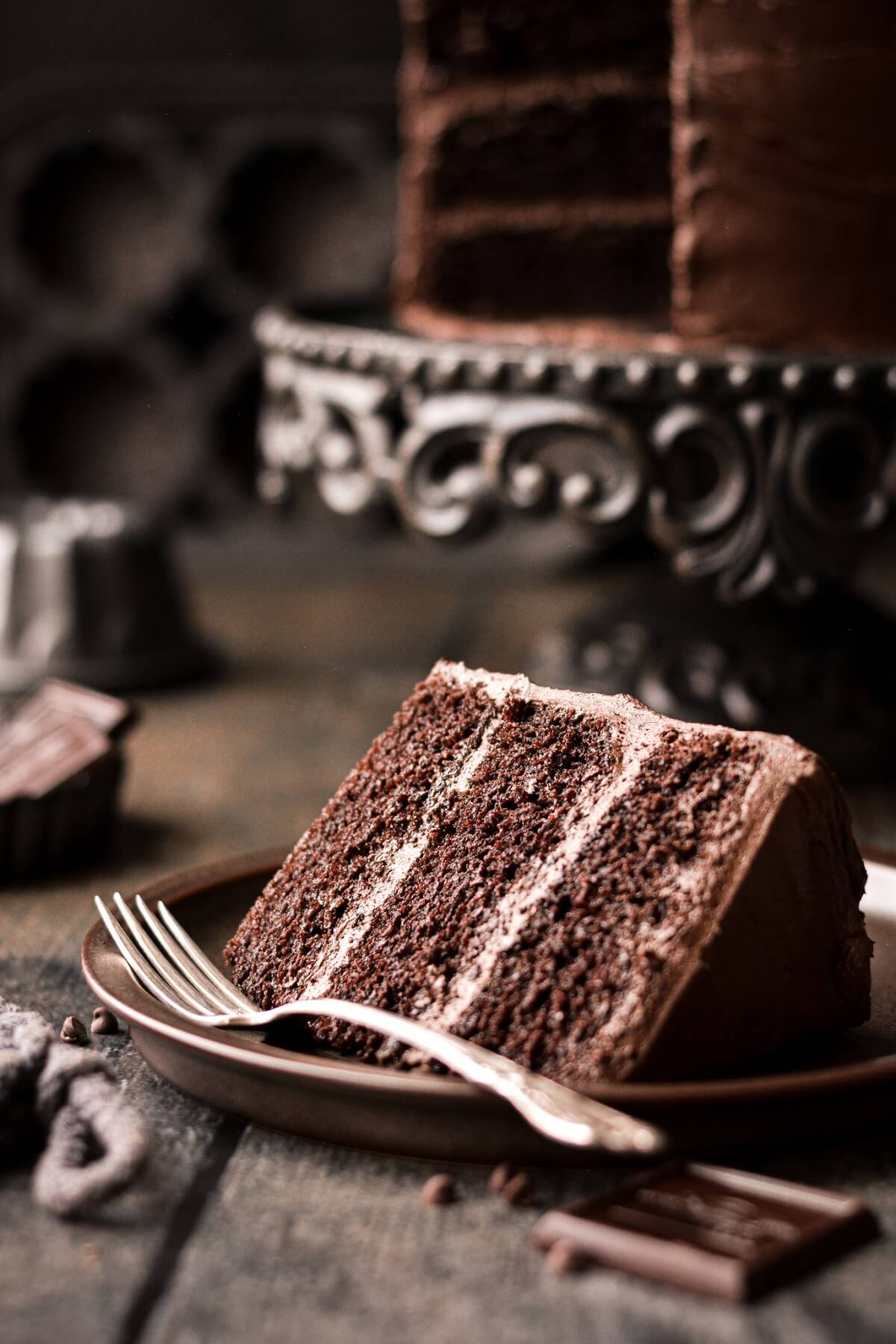
This site contains affiliate links. As an Amazon associate, I earn from qualifying purchases. This means that I may make a small commission if you purchase a product using those links. This in no way affects my opinion of those products and services. All opinions expressed on this site are my own.
Choosing a Cocoa Powder
This chocolate cake gets its dark, rich color from Dutch processed cocoa powder. While seemingly similar products, Dutch-processed cocoa powder and natural cocoa powder have different chemical properties, so their roles within a recipe are unique. There are so many cocoa powders available, ranging from mild to dark and rich, and they will all make a very different tasting chocolate cake.
So What is Cocoa Powder?
When cacao beans are processed (fermented, dried, roasted and cracked into nibs), the cocoa butter is removed from the nibs and dried. The leftover dried solids from the cocoa butter are then ground into cocoa powder. The ground cocoa powder can then be used to add rich, intense chocolate flavor to baked goods and desserts. Think chocolate cakes, brownies, cookies, chocolate pudding, and buttercream.
Dutch Processed Cocoa Powder vs Natural Cocoa Powder
Dutch processed cocoa powder begins with cacao beans that have been washed in an alkaline solution of potassium carbonate. The wash neutralizes their acidity, so the cocoa powder made from these beans is non-acidic. The alkalization process creates a cocoa powder that’s darker in color and more mellow in flavor, for a rich, deep chocolate flavor and color in your baked goods.
Natural cocoa powder is made from beans that have not been alkalized, so they are natural. It’s acidic and bitter, with a very strong flavor.
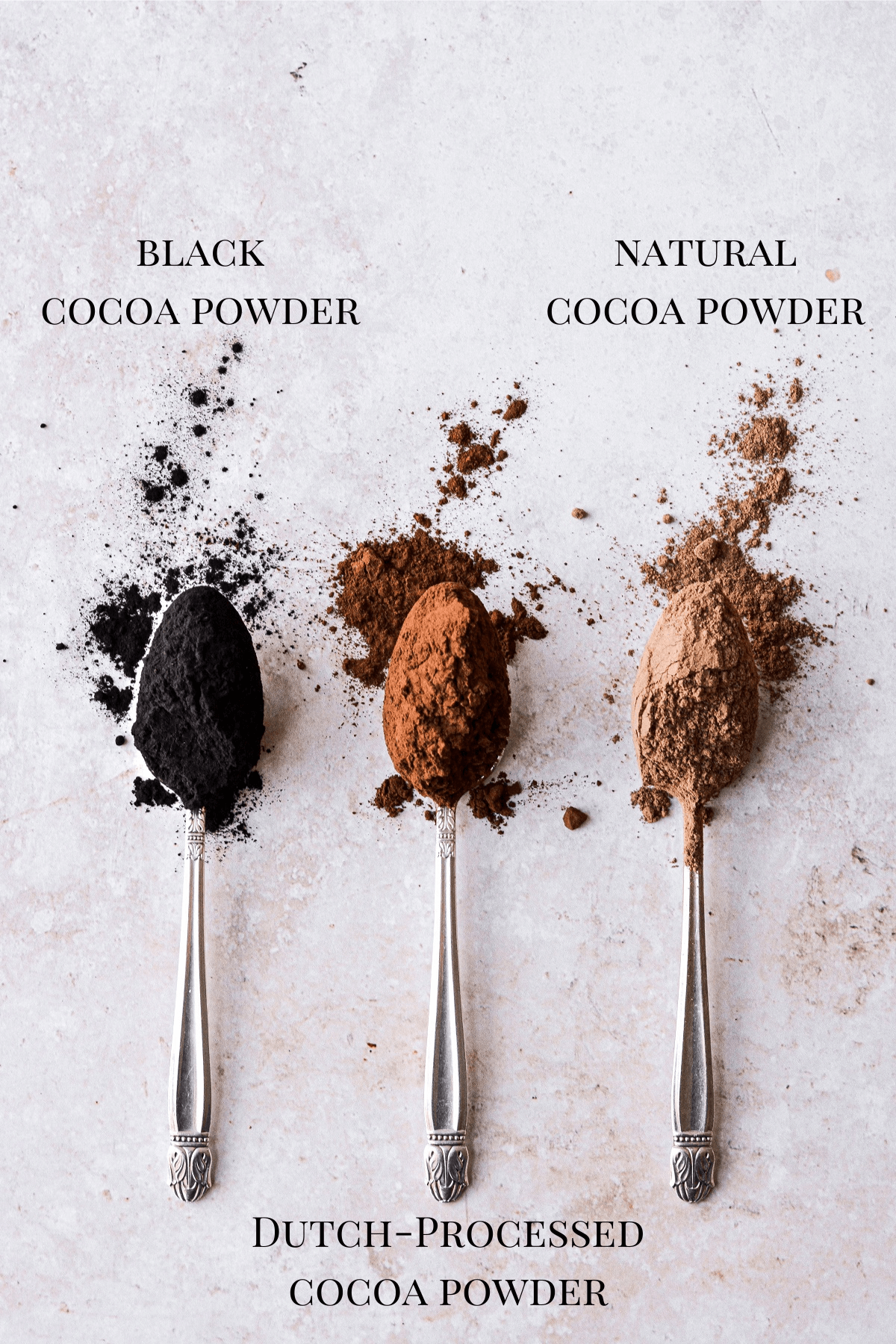
Which cocoa powder should you use?
Understanding the chemical properties of cocoa powder is important, so you know when you should use each. If the recipe doesn’t contain any leavening, for example pudding, ice cream, buttercream or brownies, you can use either one.
But for recipes containing leavening, first you’ll need to understand the difference between baking powder and baking soda. Baking soda is sodium bicarbonate, which requires an acid and a liquid to become activated and help baked goods rise. On the other hand, baking powder includes sodium bicarbonate, as well as an acid. It only needs a liquid to become activated.
Generally speaking, Dutch processed cocoa powder (non-acidic) will be paired with baking powder (doesn’t require an acid to become activated). And natural cocoa powder (acidic) will be paired with baking soda (requires an acid to become activated). Now, this is a big generalization, because most recipes contain many acidic ingredients (for example, applesauce, buttermilk, sour cream, honey, brown sugar, molasses, cream of tartar, lemon juice, vinegar, chocolate, cocoa powder, coffee or espresso powder). So even if you use Dutch processed cocoa powder with baking soda, but your cake contains other acidic ingredients, it’s likely that your cake will still rise just fine. I make my chocolate cake with Dutch processed cocoa powder, and use both baking soda and baking powder.
If a recipe doesn’t specify which cocoa powder to use (many older recipes don’t), then a safe bet is that natural cocoa powder was used.
My personal favorite cocoa powders to use are Rodelle, Drost, Cacao Barry Extra Brute, and King Arthur Baking Company.
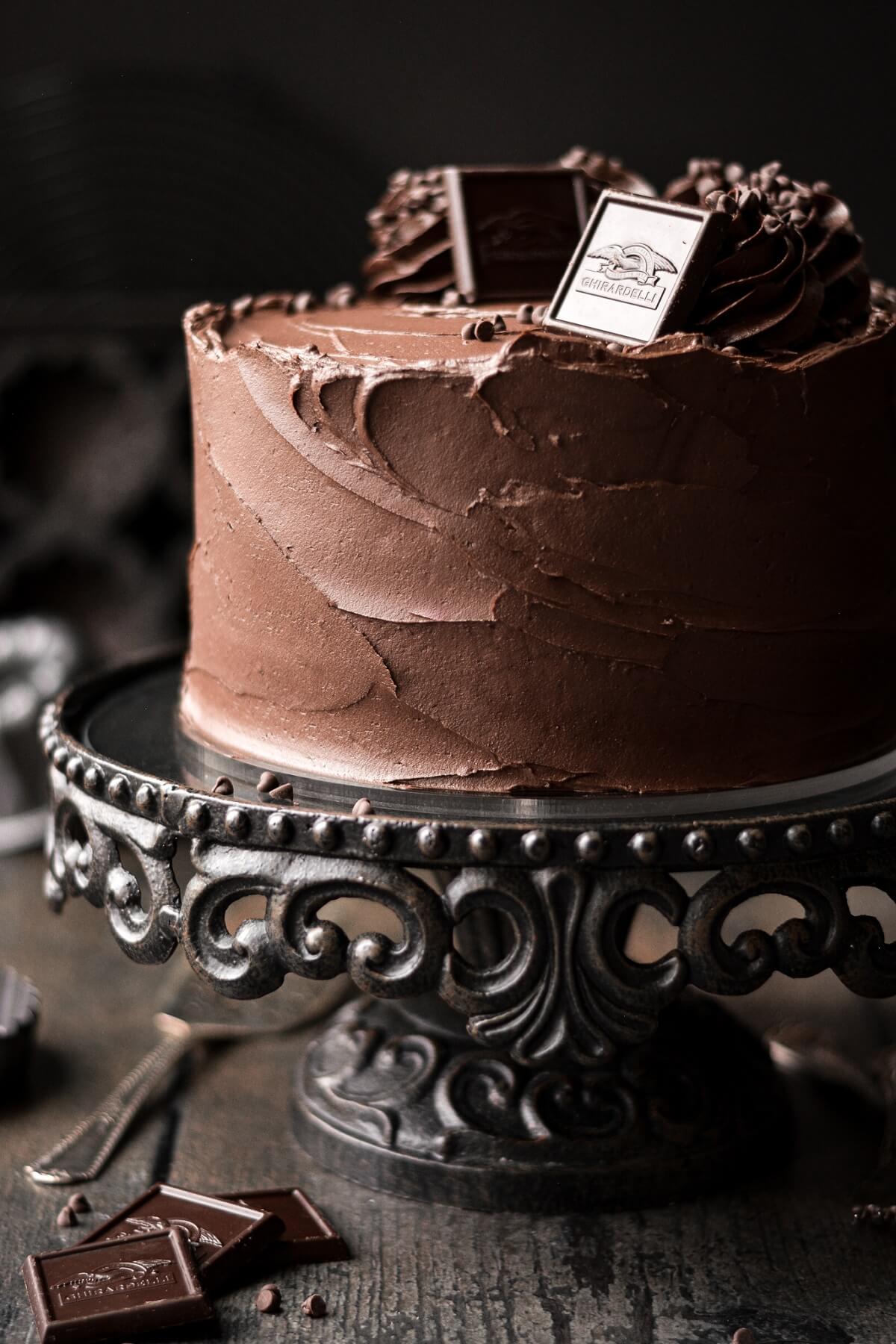
See the recipe card at the end of the post for the full ingredients list and instructions.
Ingredients
Cake
- All-Purpose Flour. Adds structure to the cake.
- Cocoa Powder. Gives chocolate cake its chocolate flavor and rich color.
- Granulated Sugar. Adds sweetness and moisture.
- Espresso Powder. A small amount of espresso powder enhances the flavor of the cocoa powder, without making the cake taste like coffee.
- Baking Powder + Baking Soda. Leavens the cake so it rises.
- Coarse Kosher Salt. Balances the sweetness.
- Eggs. Add structure.
- Whole Milk + Sour Cream. Moisture, fat, flavor and acidity.
- Vegetable Oil. Moisture.
- Vanilla Extract. Complements the flavor of the chocolate.

Buttercream
- Unsalted Butter. Adds richness, fat and flavor.
- Powdered Sugar. Sweetens and thickens the buttercream.
- Cocoa Powder. Gives the buttercream its chocolate flavor.
- Meringue Powder. Improves the texture and stabilizes the buttercream.
- Coarse Kosher Salt. Balances the sweetness.
- Vanilla Extract. Complements the flavor of the chocolate.
- Milk. Thins the buttercream for desired consistency.
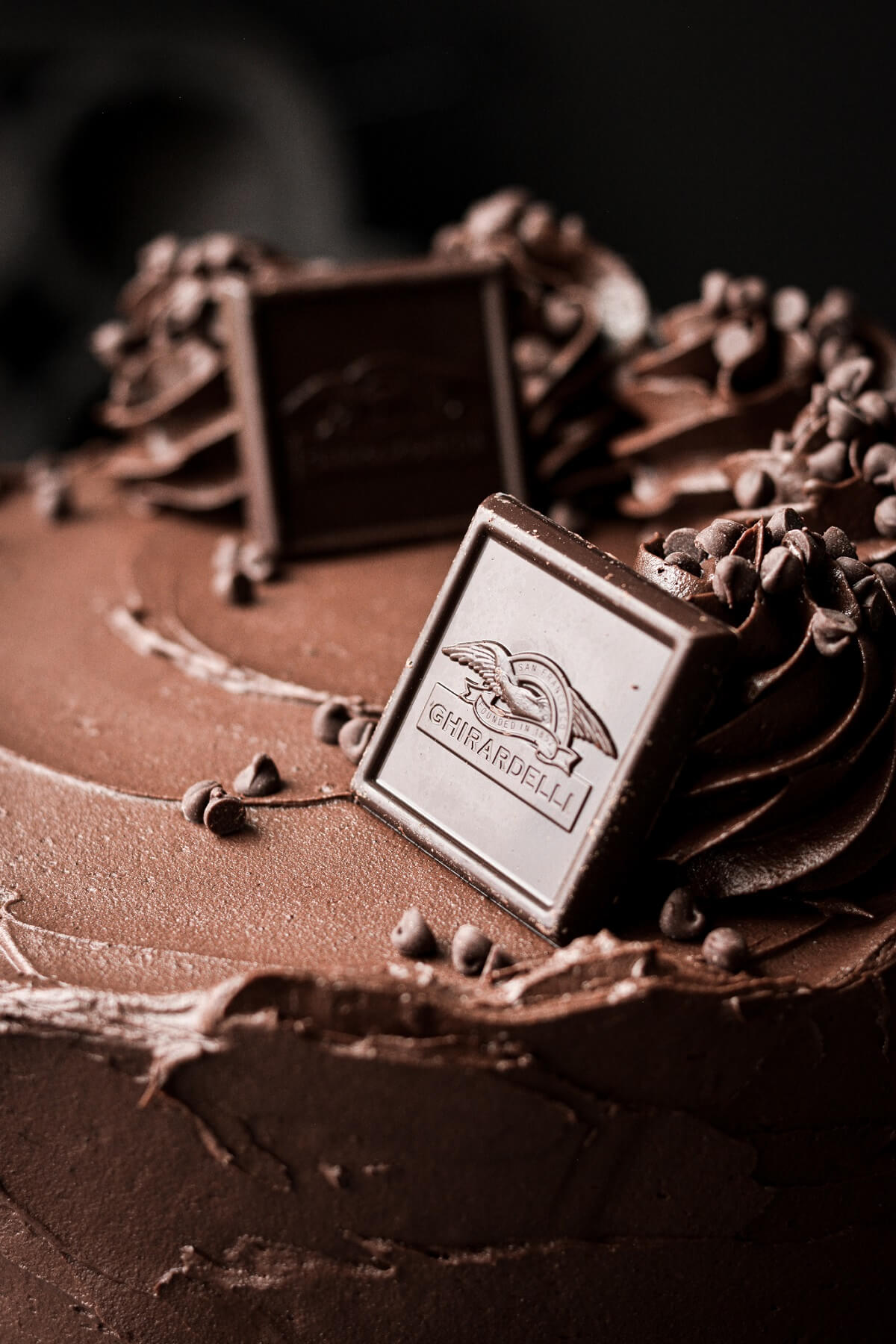
Instructions
Make the cake.
- Preheat the oven to 350 F, and spray the bottoms of three 8-inch cake pans with non-stick spray. If making half the recipe, use three 6-inch cake pans.
- In a large bowl, sift together the flour, sugar, cocoa powder, espresso powder, baking soda, baking powder and salt.
- Separately, whisk together the eggs, milk, sour cream, oil and vanilla. Add the wet ingredients to the dry, and whisk until combined, about 15 seconds.
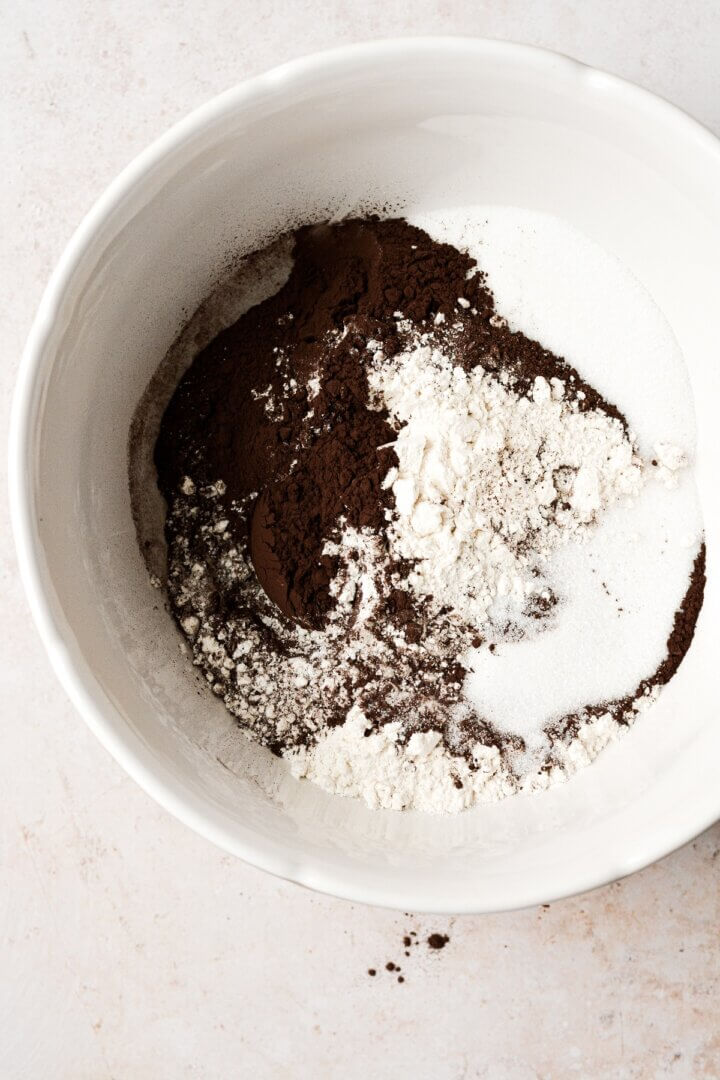
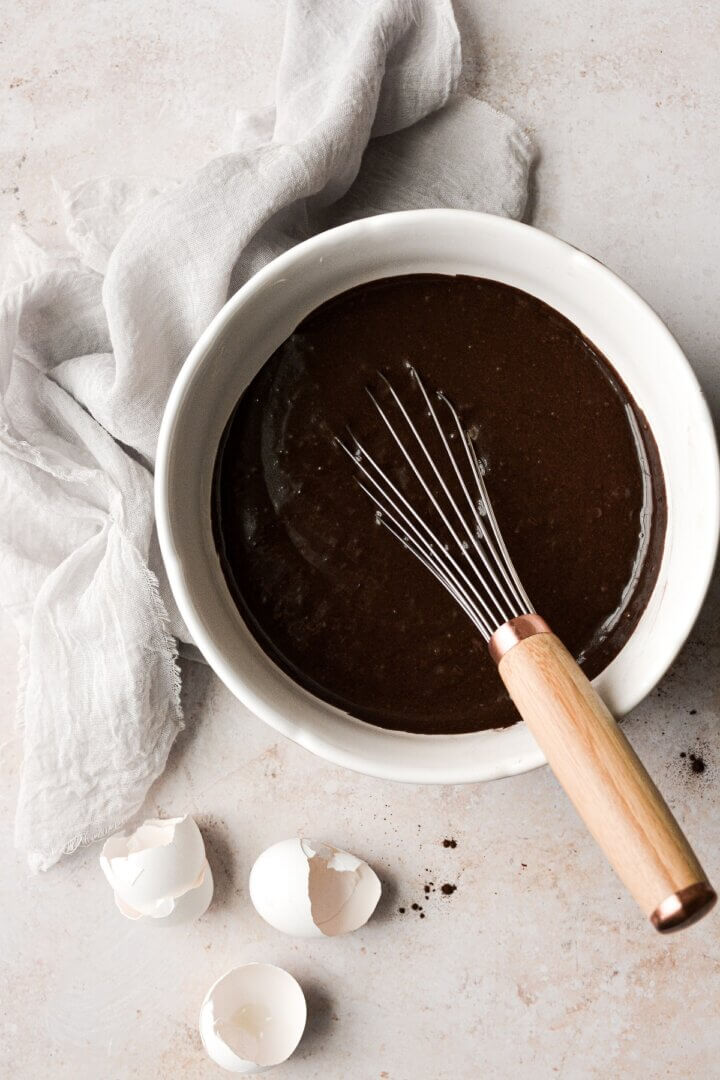
- Divide the batter between the pans. Bake on the center oven rack for about 22-28 minutes (or about 20 minutes for 6-inch pans), until the tops of the cakes spring back when lightly touched, or a toothpick inserted in the center comes out clean.
- Set the pans on a cooling rack, cover loosely with a clean kitchen towel, and cool completely before frosting.
Make the buttercream.
- In the bowl of your stand mixer fitted with the whisk attachment, beat the butter on medium speed for 1 minute until smooth.
- With the mixer on low, gradually add the powdered sugar, cocoa powder, meringue powder and salt, mixing to combine.
- Add the vanilla, and increase the speed to medium (#4-6 on a Kitchen Aid mixer); whip for 4-5 minutes until very light and fluffy, scraping the bowl down occasionally, and only adding the milk if needed for desired consistency. Turn the speed down to “stir” and mix for 2 minutes to eliminate big air bubbles.
- Remove the cooled cakes from the pans. Place one cake layer on a cake board, and frost with a layer of buttercream. Repeat stacking and filling the cake layers, then frost all over with a thin “crumb coat” of buttercream. Refrigerate for 30 minutes to set the crumb coat. Keep the bowl of remaining buttercream covered. Frost all over with a final, swirly layer of buttercream.
- If you have any extra buttercream leftover, fit a piping bag with tip 1M, fill with the buttercream, and pipe a few swirls on top of the cake. Decorate with chocolate squares.
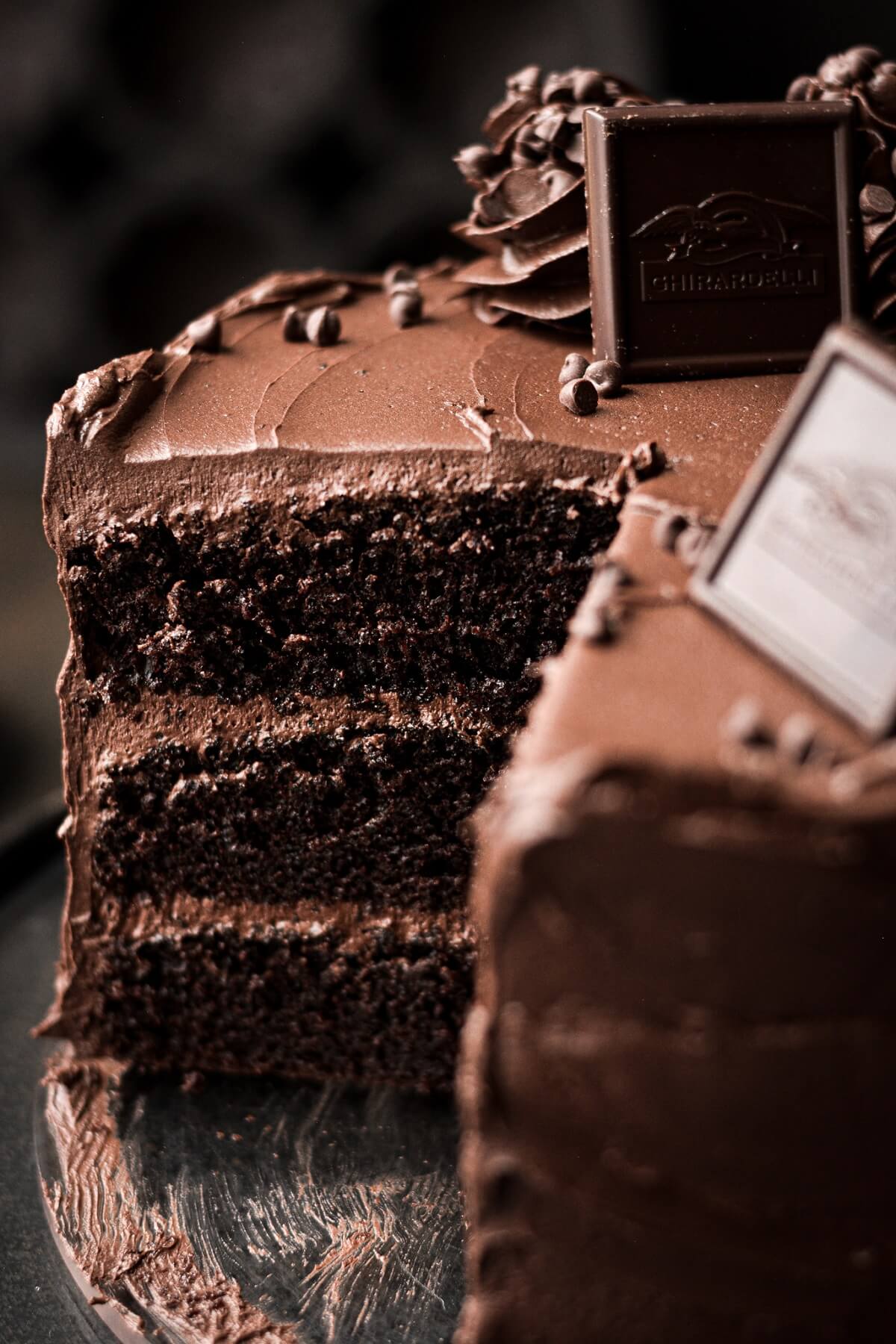
Be sure to read all of my BAKING FAQs where I discuss ingredients, substitutions and common questions with cake making, so that you can be successful in your own baking! I also suggest reading these comprehensive posts on making Perfect American Buttercream, How to Stack, Fill, Crumb Coat and Frost Layer Cakes and How to Use Piping Bags.
Frequently Asked Questions
What cocoa powder should I use for my cake?
Use a good-quality Dutch-processed cocoa powder for the best flavor. My personal favorite cocoa powders to use are Rodelle, Drost, Cacao Barry Extra Brute, and King Arthur Baking Company.
Is this cake fluffy or fudgy?
This is a light and fluffy, not fudgy, chocolate cake with an incredibly moist, tender crumb. Here is my chocolate fudge cake recipe.
Can I use melted butter instead of oil?
You really should use the oil, as it makes the cake very light, moist and fluffy. Butter will make the cake a bit more dense and dry.
How can I make an eggless chocolate cake?
The price of eggs has risen sky high the last few months, so I tested my recipe with an easy egg substitute. To make an eggless chocolate cake, simply replace the eggs with 1 cup of unsweetened applesauce (1/4 cup of applesauce for each egg) and increase the flour by 3 tablespoons. This makes an exceptionally moist chocolate cake without eggs, that rises just as well as the version with eggs. And the apple flavor is extremely subtle, since the cocoa powder has a much more pronounced flavor. I tested this eggless version with 1/2 the cake recipe, baked in a 9-inch square baking pan for about 35 minutes.
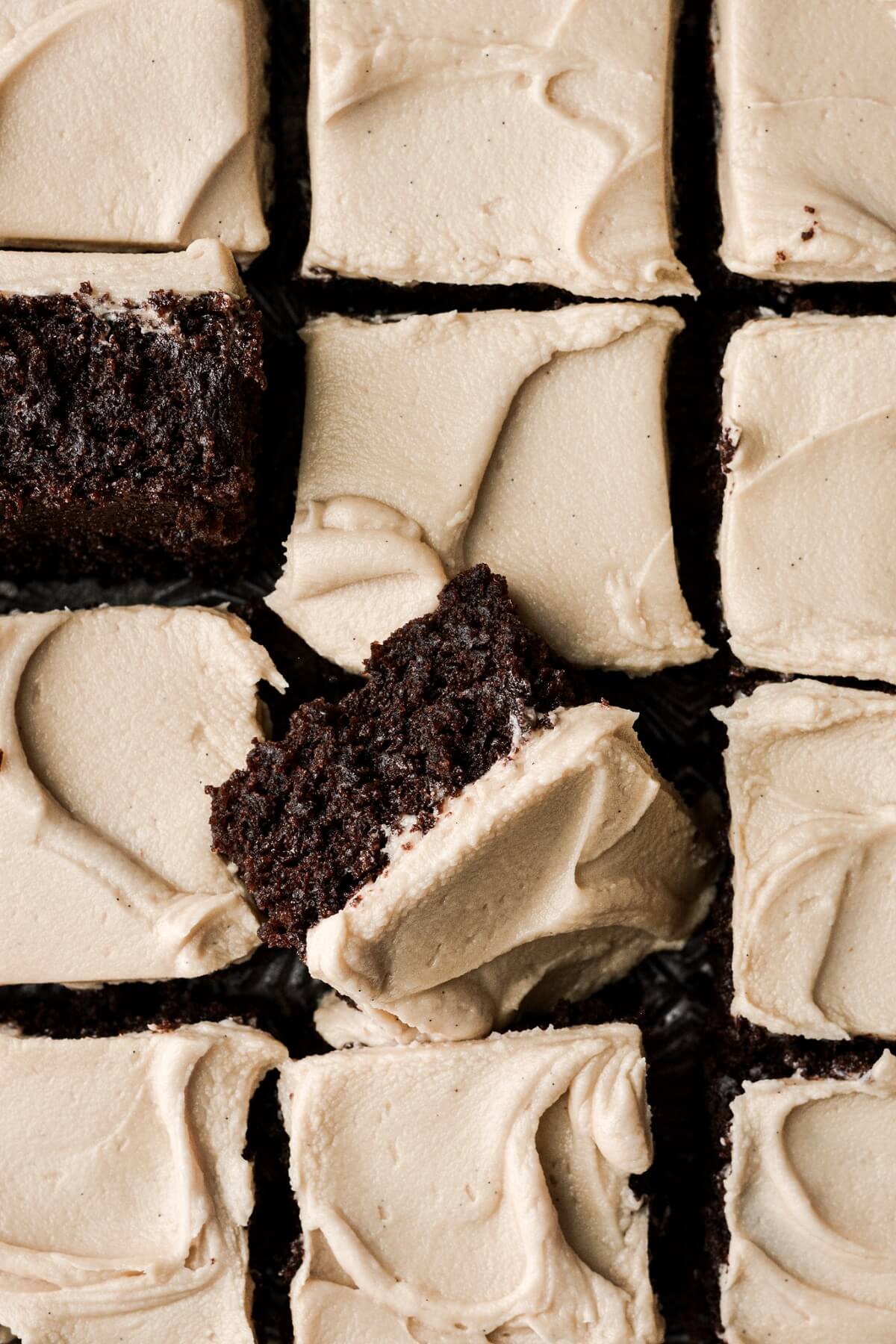
Can I use gluten free flour in this recipe?
Yes, just substitute your favorite measure-for-measure gluten free flour in place of the all-purpose flour.
Why don’t you use cake flour instead of all-purpose flour?
While I love using cake flour for my white cake and vanilla cake, all-purpose flour works perfectly for chocolate cake.
What does the espresso powder do?
A tablespoon or two of espresso powder enhances the flavor of chocolate, but isn’t enough to make the cake taste like coffee. It also adds acidity, which reacts with the leavening to help the cake rise, and give it a fluffy, tender texture. I use Medaglia D’Oro Instant Espresso Coffee, which I can find at my local grocery store.
What can I substitute for the whole milk and sour cream?
Whole milk and full fat sour cream are preferred in this recipe for their rich, creamy flavor. You can, however, use any milk you like, including dairy-free options. If you don’t have sour cream, you can try full-fat, unsweetened Greek yogurt or buttermilk, although I haven’t tested these substitutions.
Should I adjust this recipe if I don’t live at high altitude?
If you’re at sea level or low altitude, you may be able to make this recipe exactly as written, but then again, you might need to make a few minor adjustments, such as decreasing the flour by a couple of tablespoons, and increasing the leavening a little. If you’re at a higher altitude than Denver (by more than 1,000 feet), I’d advise increasing the flour by a couple of tablespoons, and slightly decreasing the leavening. This article has great guidelines on how to make specific adjustments for various altitudes.
How should I adjust the recipe for a smaller cake?
You can make half the recipe and bake it in three 6-inch cake pans for a smaller cake.
What other buttercream flavors pair well with chocolate cake?
Pretty much everything is great with chocolate cake! I’d recommend vanilla sour cream buttercream, salted caramel, raspberry, espresso, or peanut butter. And cream cheese buttercream would be fantastic, too.
Other Resources
How to Fill, Stack, Crumb Coat and Frost a Layer Cake
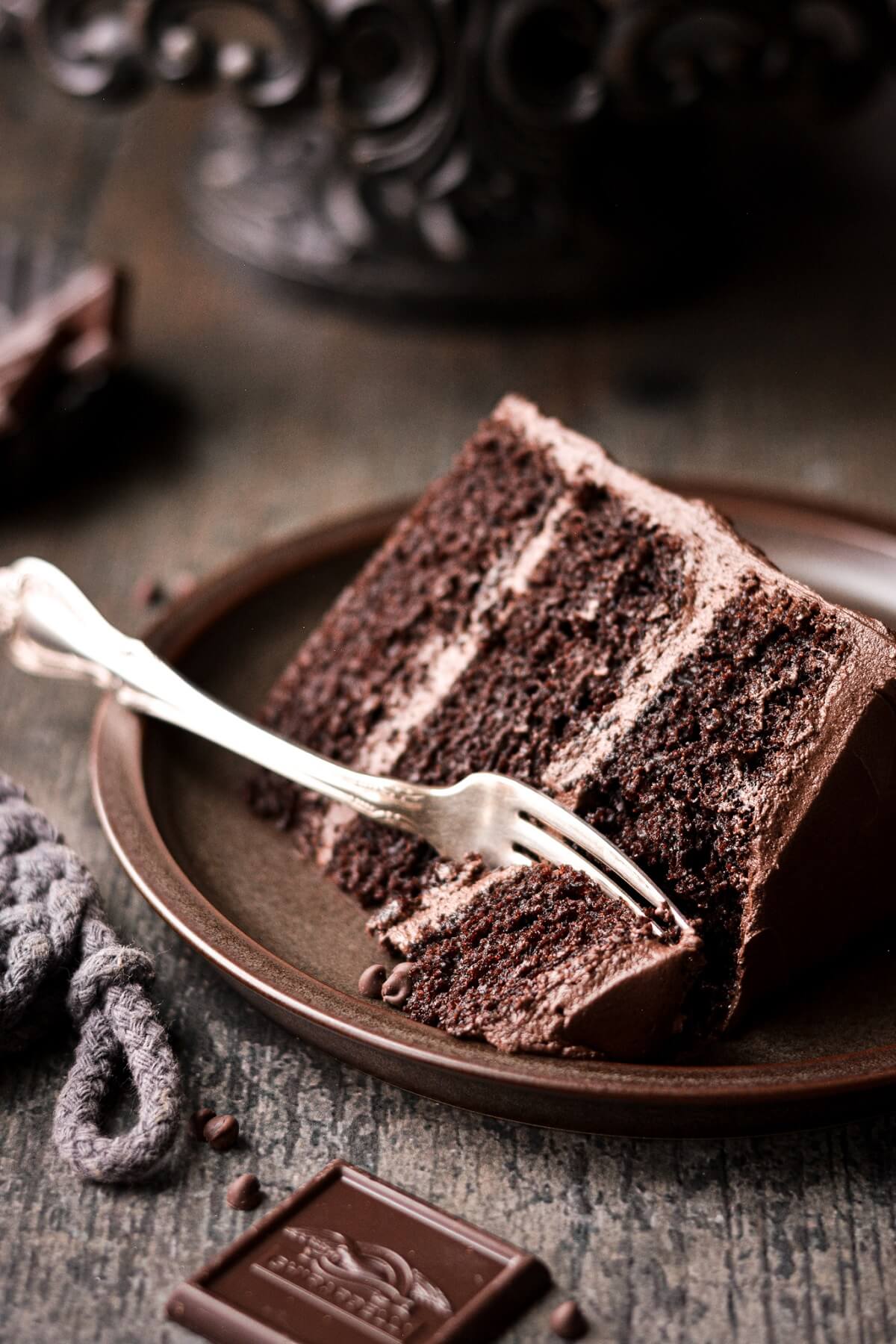
You Might Also Like
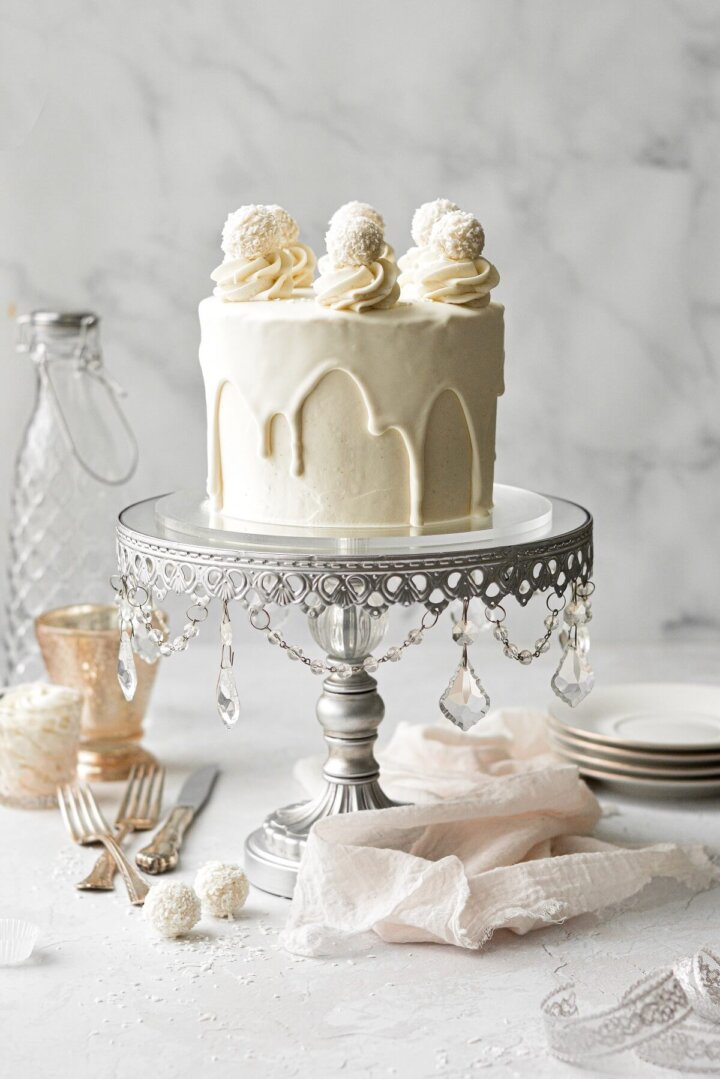
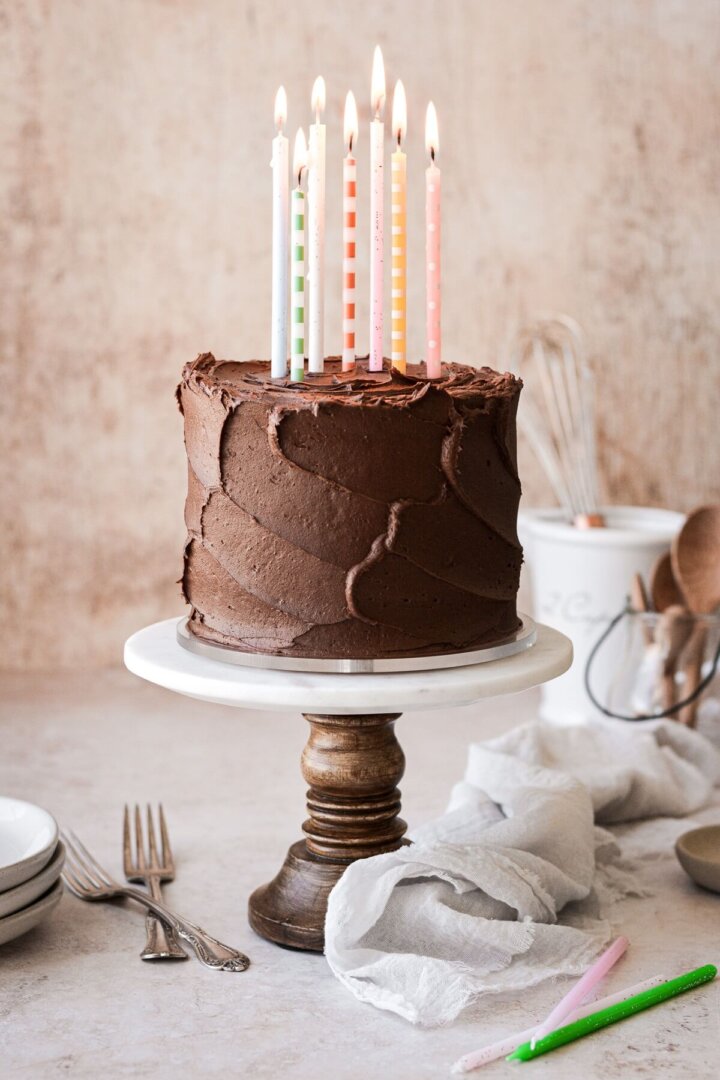
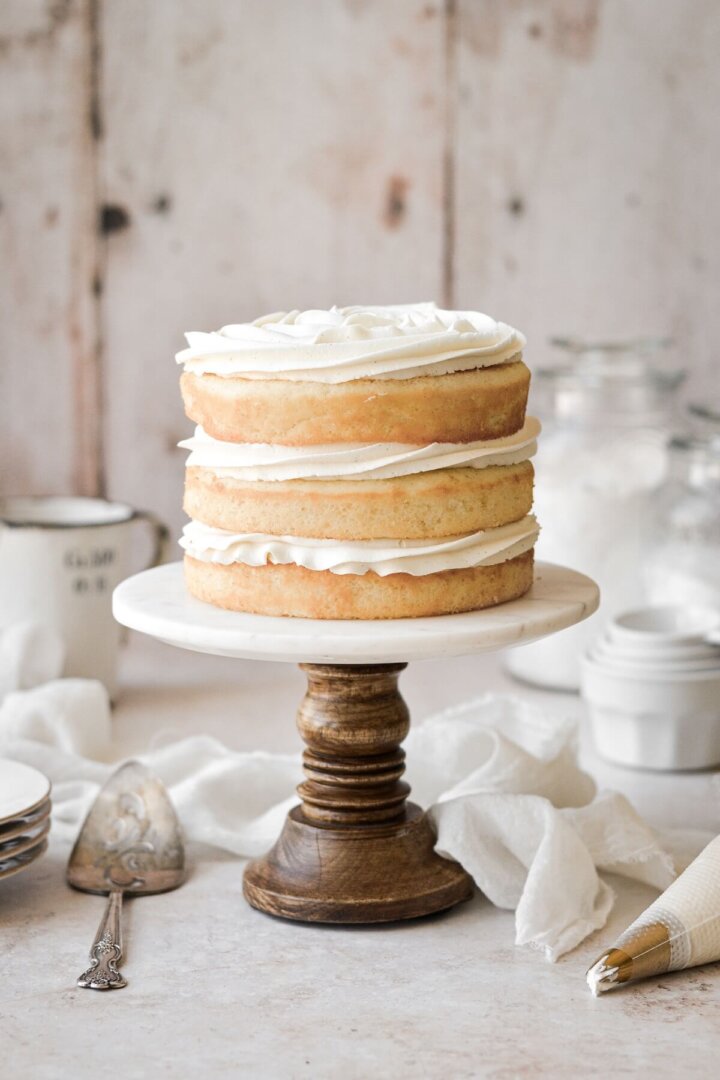
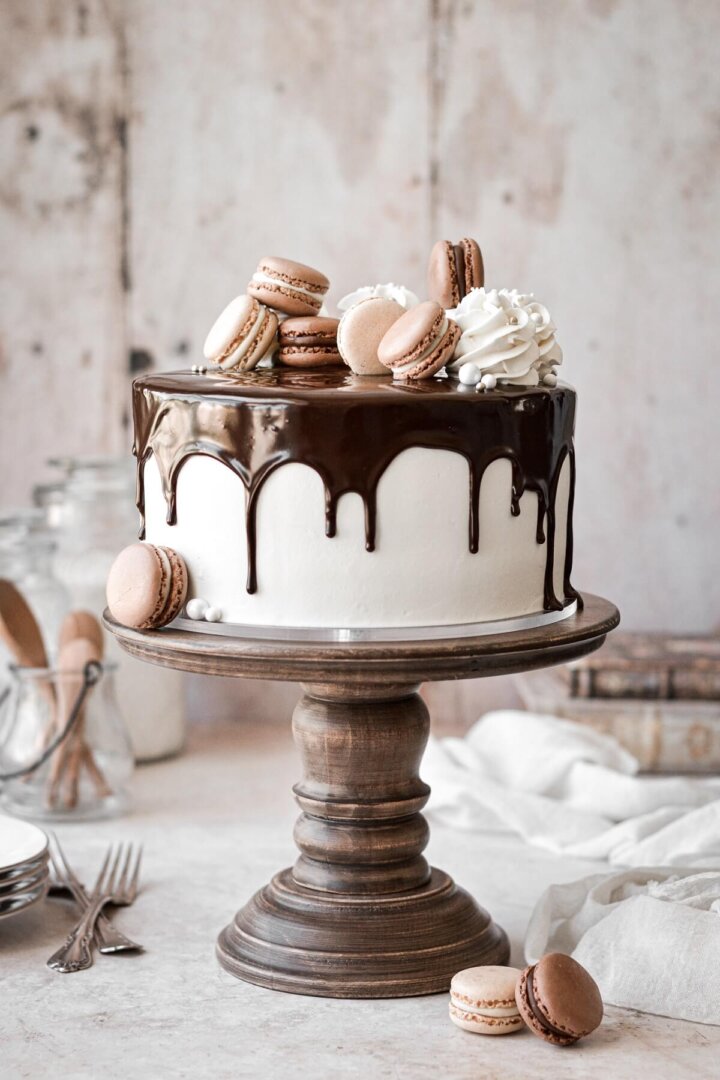
Please check out my Amazon Shop for a curated collection of some of my favorite cake pans from trusted brands, baking tools, ingredients, pretty things and fashion finds. I recommend products that I buy and use every day!
Did you love today’s recipe? Please rate the recipe and let me know in the comments what you thought! Also, be sure to follow Curly Girl Kitchen on Instagram, and tag me when you try one of my recipes so I can see all your delicious creations!
The Best High Altitude Chocolate Cake
All recipes on Curly Girl Kitchen are developed for high altitude at 5,280 feet. See FAQs for adjusting to higher or lower elevations.
Equipment
- Stand Mixer with Whisk Attachment
- 8-inch cake pans (x3)
Ingredients
Cake
- 2 cups all-purpose flour, spooned and leveled
- 1 ¾ cups granulated sugar
- ¾ cup unsweetened, Dutch-processed cocoa powder
- 2 tbsp instant espresso powder or instant coffee
- 1 tsp baking soda
- ½ tsp baking powder
- 1 tsp coarse Kosher salt (if using table salt, use half the amount)
- 4 large eggs, room temperature
- 1 cup whole milk, room temperature
- 1 cup sour cream, room temperature
- 1 cup vegetable oil
- 1 tbsp vanilla extract
Buttercream
- 2 cups unsalted butter, softened to room temperature
- 3 cups powdered sugar
- 1 cup unsweetened, Dutch-processed cocoa powder, sifted to break up lumps
- 1 tbsp meringue powder, optional
- ¼ tsp coarse Kosher salt (if using table salt, use half the amount)
- 2 tsp vanilla extract
- 2-4 tbsp milk, if needed
Instructions
Cake
- Preheat the oven to 350 F, and spray the bottoms of three 8-inch cake pans with non-stick spray. If making half the recipe, use three 6-inch cake pans.
- In a large bowl, sift together the flour, sugar, cocoa powder, espresso powder, baking soda, baking powder and salt.
- Separately, whisk together the eggs, milk, sour cream, oil and vanilla. Add the wet ingredients to the dry, and whisk until combined, about 15 seconds.
- Divide the batter between the pans. Bake on the center oven rack for about 22-28 minutes, until the tops of the cakes spring back when lightly touched, or a toothpick inserted in the center comes out clean.
- Set the pans on a cooling rack, cover loosely with a clean kitchen towel, and cool completely before frosting.
Buttercream
- In the bowl of your stand mixer fitted with the whisk attachment, beat the butter on medium speed for 1 minute until smooth.
- With the mixer on low, gradually add the powdered sugar, cocoa powder, meringue powder and salt, mixing to combine.
- Add the vanilla, and increase the speed to medium (#4-6 on a Kitchen Aid mixer); whip for 4-5 minutes until very light and fluffy, scraping the bowl down occasionally, and only adding the milk if needed for desired consistency.Turn the speed down to "stir" and mix for 2 minutes to eliminate big air bubbles.
- Remove the cooled cakes from the pans. Place one cake layer on a cake board, and frost with a layer of buttercream. Repeat stacking and filling the cake layers, then frost all over with a thin "crumb coat" of buttercream. Refrigerate for 30 minutes to set the crumb coat. Keep the bowl of remaining buttercream covered. Frost all over with a final, swirly layer of buttercream.
- If you have any extra buttercream leftover, fit a piping bag with tip 1M, fill with the buttercream, and pipe a few swirls on top of the cake. Decorate with chocolate squares.

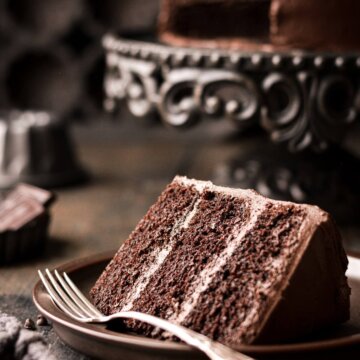
I live in Littleton, Colorado, and have often looked for a good chocolate cake for high altitude. This cake worked perfectly. It came out of the pans cleanly, and it tasted great. Thanks!
Absolutely perfect chocolate cake! So delicious, and super moist every time.
I want to make a sheet cake this time around, do you think one batch of this recipe will be good for a 9×13 cake pan?
Yes, it works great as a sheet cake, too. You can see how I made one in this post: https://curlygirlkitchen.com/high-altitude-chocolate-sour-cream-sheet-cake/
I live in the mountains of Southern Califonia at 6500 feet. I had two chocolate cakes fall today while trying to make a birthday cake for my granddaughter. I found your cake recipe while in tears and almost out of ingredients. Thank you! I have a beautiful 3-layer chocolate cake.
I’m so glad it was a success and the birthday cake has been saved. 🙂
Worked like a champ at 6500 feet!! Thank you so much!
Came out beautiful at 6,100 feet in Golden, CO. Thank you thank you thank you!!!!
I have yet to try it as it’s cooling – but the cake hasn’t fallen! I have issues with every home made cake of falling and so happy it hasn’t fallen!
This is the most delicious chocolate cake I’ve ever eaten! Bravo 😁
I’ve tried several of your high altitude recipes and recipes and all have well exceeded my expectation for structure and wonderful taste Thank you so much for all your hard work on the recipes!!!
In Denver, CO and it’s a perfect birthday cake every time for my kids! Thank you!